TELEGRID Technologies WRN320V2 WZRDnet Relay Node WRN-320(V)2 User Manual USM320 V 2 121103
TELEGRID Technologies, Inc. WZRDnet Relay Node WRN-320(V)2 USM320 V 2 121103
USERS MANUAL

TELEGRID Technologies, Inc.
19 Microlab Road
Livingston, NJ 07039
Tel (973) 994-4440
e-mail: telegrid@telegrid.com
Copyright ©2012 TELEGRID Technologies, Inc.
WZRDnet®
Repeater WRN-320(V)2
User Manual
Version 1.2.1
Document No.: USM320(V)2-121103
11/03/2012
TELEGRID Technologies, Inc.
19 Microlab Road
Livingston, NJ 07039
(973) 994-4440
info@telegrid.com
www.telegrid.com

WRN-320(V)2 User Manual
2
5 SAFETY STEPS TO FOLLOW IF SOMEONE IS THE VICTIM
OF ELECTRICAL SHOC
K
4 SEND FOR HELP AS SOON AS POSSIBLE
2 IF POSSIBLE, TURN OFF THE ELECTRICAL POWER
3 IF YOU CANNOT TURN OFF THE ELECTRICAL POWER,
PULL, PUSH, OR LIFT THE PERSON TO SAFETY USING A
DRY WOODEN POLE OR A DRY ROPE OR SOME OTHER
INSULATING MATERIAL
1 DO NOT TRY TO PULL OR GRAB THE INDIVIDUAL
5 AFTER THE INJURED PERSON IS FREE OF CONTACT WITH
THE SOURCE OF ELECTRICAL SHOCK, MOVE THE
PERSON A SHORT DISTANCE AWAY AND IMMEDIATELY
START ARTIFICIAL RESUSCITATION. REFER TO FM 21-11
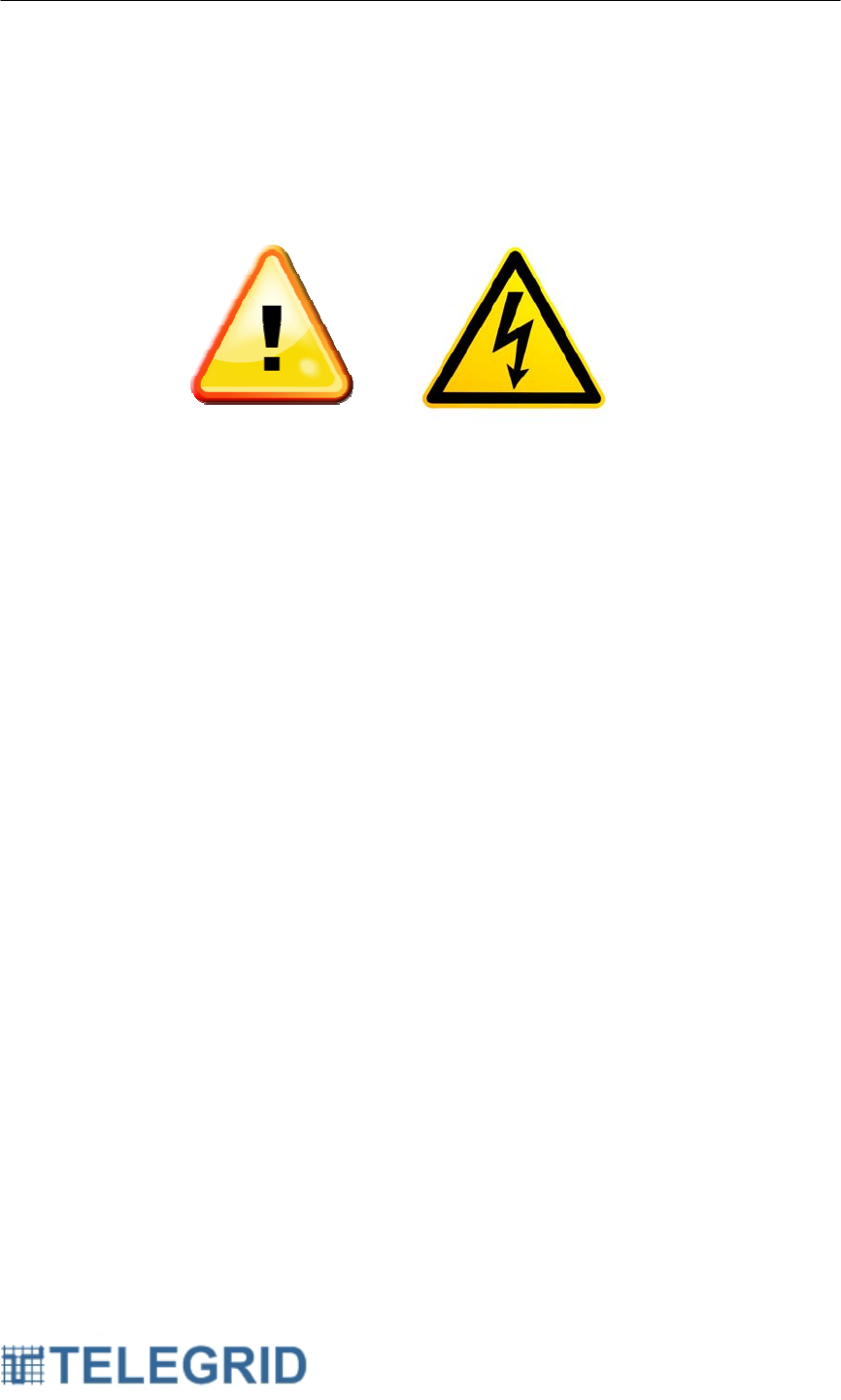
WRN-320(V)2 User Manual
3
WARNING
HIGH VOLTAGE
High Voltage is used in the operation of this equipment. Be careful when working
near AC power distribution. Observe warning notes in this technical manual and
warning decals on equipment. Death on contact may result if safety precautions
are not observed.
Never work on electronic equipment unless there is another person nearby who
is familiar with the operation and hazards of the equipment and who is competent
in administering first aid. When technicians are aided by operators, they must be
warned about dangerous areas. Whenever possible, the power supply to the
equipment must be shut off before beginning work on the equipment.
Be careful not to come into contact with high-voltage connections or 115 volt AC
input connections when installing or operating this equipment.
Whenever the nature of the operation permits, keep one hand away from the
equipment to reduce the hazard of current flowing through the body.
Do not be misled by the term “low voltage.” Voltages as low as 50 volts may
cause death under adverse conditions.
For artificial respiration refer to FM 21-11.
SHOCK WARNING
To avoid shock and damage to equipment, be certain the POWER switch is set
to OFF position and the power cable is disconnected at the power source before
disconnecting the signal cables.

WRN-320(V)2 User Manual
4
TABLE OF CONTENTS
SECTION 1: GENERAL INFORMATION ................................................................... 6
1. Introduction ............................................................................................................. 6
2. Features ................................................................................................................... 6
SECTION 2: EQUIPMENT DESCRIPTION ................................................................ 7
1. Repeater Characteristics .......................................................................................... 7
SECTION 3: REPEATER POWER ............................................................................... 8
1. Repeater Power ....................................................................................................... 8
1.1 Battery Charging ............................................................................................. 8
1.2 Battery LED .................................................................................................... 8
SECTION 4: MODES OF OPERATION ....................................................................... 9
1. Start-up Mode ......................................................................................................... 9
2. Power-on Mode ....................................................................................................... 9
3. Power-off Mode ...................................................................................................... 9
3.1 Controlled Power off....................................................................................... 9
3.2 Uncontrolled Power-off .................................................................................. 9
4. No Supply Mode ..................................................................................................... 9
SECTION 5: NETWORK COMMUNICATIONS ...................................................... 10
1. Overview ............................................................................................................... 10
2. Mesh Networking.................................................................................................. 10
3. Router .................................................................................................................... 10
4. Ad-Hoc Network ................................................................................................... 10
4.1 Network Formation ....................................................................................... 10
4.2 Associating with a WMN .............................................................................. 11
5. Network Addressing ............................................................................................. 11
5.1 64-bit MAC Address ..................................................................................... 11
5.2 Node Identifier String (NI) ........................................................................... 11
SECTION 6: SECURE COMMUNICATIONS ........................................................... 11
1. Encryption ............................................................................................................. 11
1.1 Network Key ................................................................................................. 12
1.2 Key Update ................................................................................................... 12
SECTION 7: OPERATING INSTRUCTIONS ........................................................... 12
1. Network Association ............................................................................................. 12
1.1 Change Channel ............................................................................................ 12
1.2 Assigning Node Identifier Strings ................................................................ 12
2. Getting Started ...................................................................................................... 12
2.1 Buttons and Connectors ................................................................................ 12
2.2 Battery Voltage Indicator .............................................................................. 13
2.3 Charging the Battery ..................................................................................... 13
2.4 Turning ON/OFF .......................................................................................... 13
SECTION 8: TROUBLESHOOTING .......................................................................... 14
1. Mini-USB Port ...................................................................................................... 14
SECTION 9: INSTALLATION INSTRUCTIONS ..................................................... 15
SECTION 10: PRODUCT AND SAFETY INFORMATION .................................... 16
1. WRN-320(V)2 Safety Instructions ....................................................................... 16

WRN-320(V)2 User Manual
5
1.1 Battery Information ....................................................................................... 16
1.2 Antenna ......................................................................................................... 17
1.3 Health and General Use ................................................................................ 17
SECTION 11: CERTIFICATIONS .............................................................................. 19
1. Certifications ......................................................................................................... 19
1.1 FCC Notice ................................................................................................... 19
1.2 Industry Canada (IC)..................................................................................... 19
SECTION 12: LEGAL NOTICES ................................................................................ 20
1. Copyright .............................................................................................................. 20
2. Software Licensing Agreement ............................................................................. 20
3. Limited Warranty .................................................................................................. 23
4. Jurisdiction ............................................................................................................ 24

WRN-320(V)2 User Manual
6
SECTION 1: GENERAL INFORMATION
1. Introduction
This document forms the user manual for the WZRDnet Repeater Model
WRN-320(V)2. As such it presents a detailed equipment description
including the physical characteristics and operational instructions for the
Repeater.
2. Features
WZRDnet is a low-power wireless ad-hoc mesh network that provides
secure voice and data communications without the need for infrastructure
(i.e., no cell towers or satellites required). In WZRDnet each device is a
router, relaying calls from originator to destination. Unlike other mesh
networks, this architecture does not employ central routing tables thus
avoiding single points of failure. WZRDnet is a low-power network that
allows its light-weight handsets to provide service for 38 hours between
battery recharges. WZRDnet is a true end-to-end packet switched network
which facilitates straight-forward interoperability with Wide Area Networks
(WANs) supporting peer-to-peer communications and direct dialing. This is
accomplished via the WZRDnet Gateway which provides connectivity with
any available IP network (e.g., Wi-Fi, VOIP, etc.), or analog network (i.e.,
PSTN).
The WRN-320(V)2 Repeater design was focused on ease of use and
minimal set-up requirements. This reduces training time and facilitates fast
network configuration.
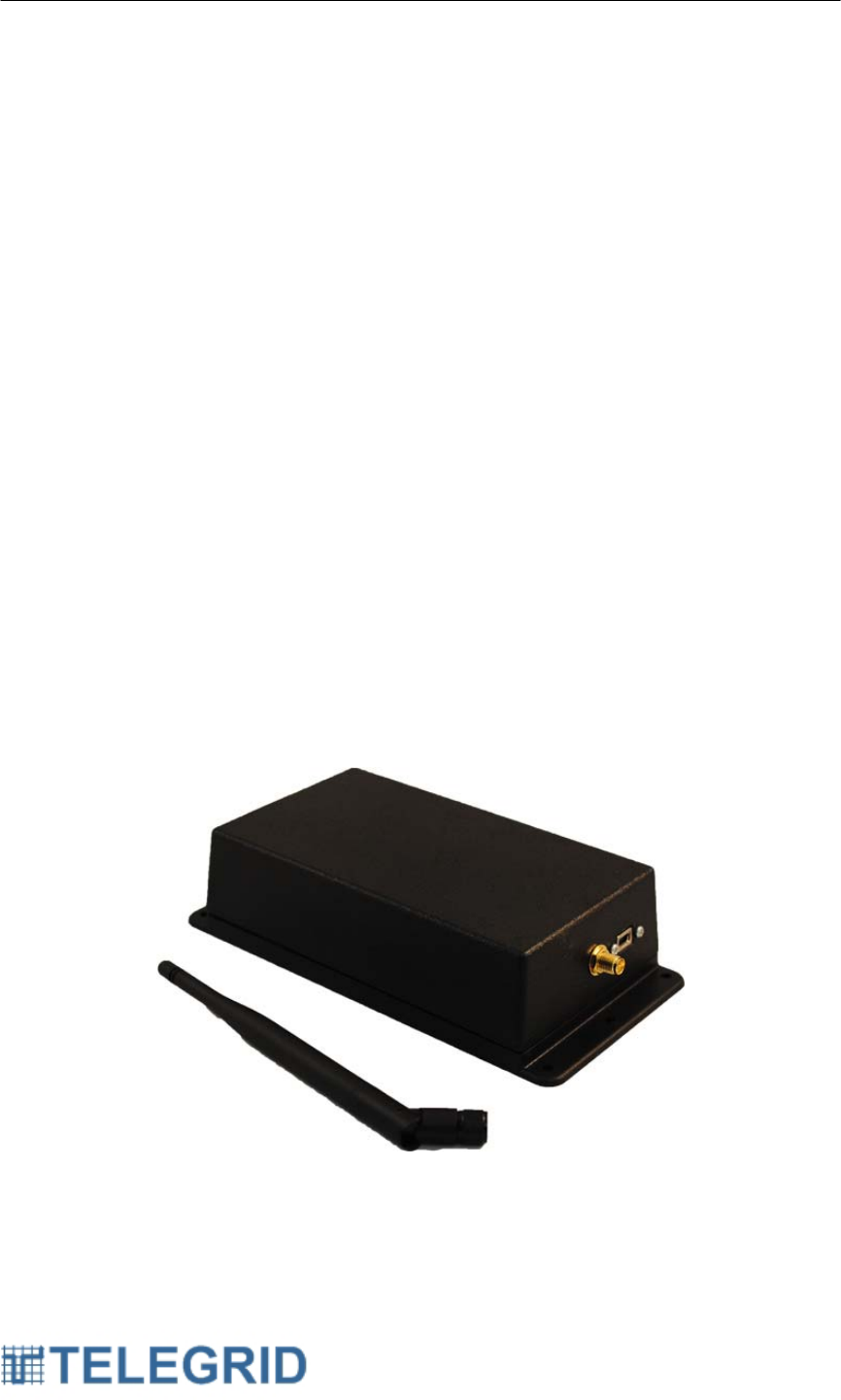
WRN-320(V)2 User Manual
7
SECTION 2: EQUIPMENT DESCRIPTION
1. Repeater Characteristics
Physical Characteristics
• Dimensions:
o Repeater: 3.3W x 6.5L x 1.62H inches
o Antenna length: 6 inches
• Weight: 0.8 lbs
Internal Components
• 2.4 GHz Radio Transceiver
• Real-Time Clock
• Rechargeable 3500mAhr Lithium Ion Battery Pack
External Connectors
• Mini-USB Port
• Reverse SMA Antenna Connector
• 90 VAC - 264VAC Inlet.
Additional Software
• USB to Serial Driver
• WZRDnet Command Center
Figure 2.1.1 WRN-320(V)2 Repeater
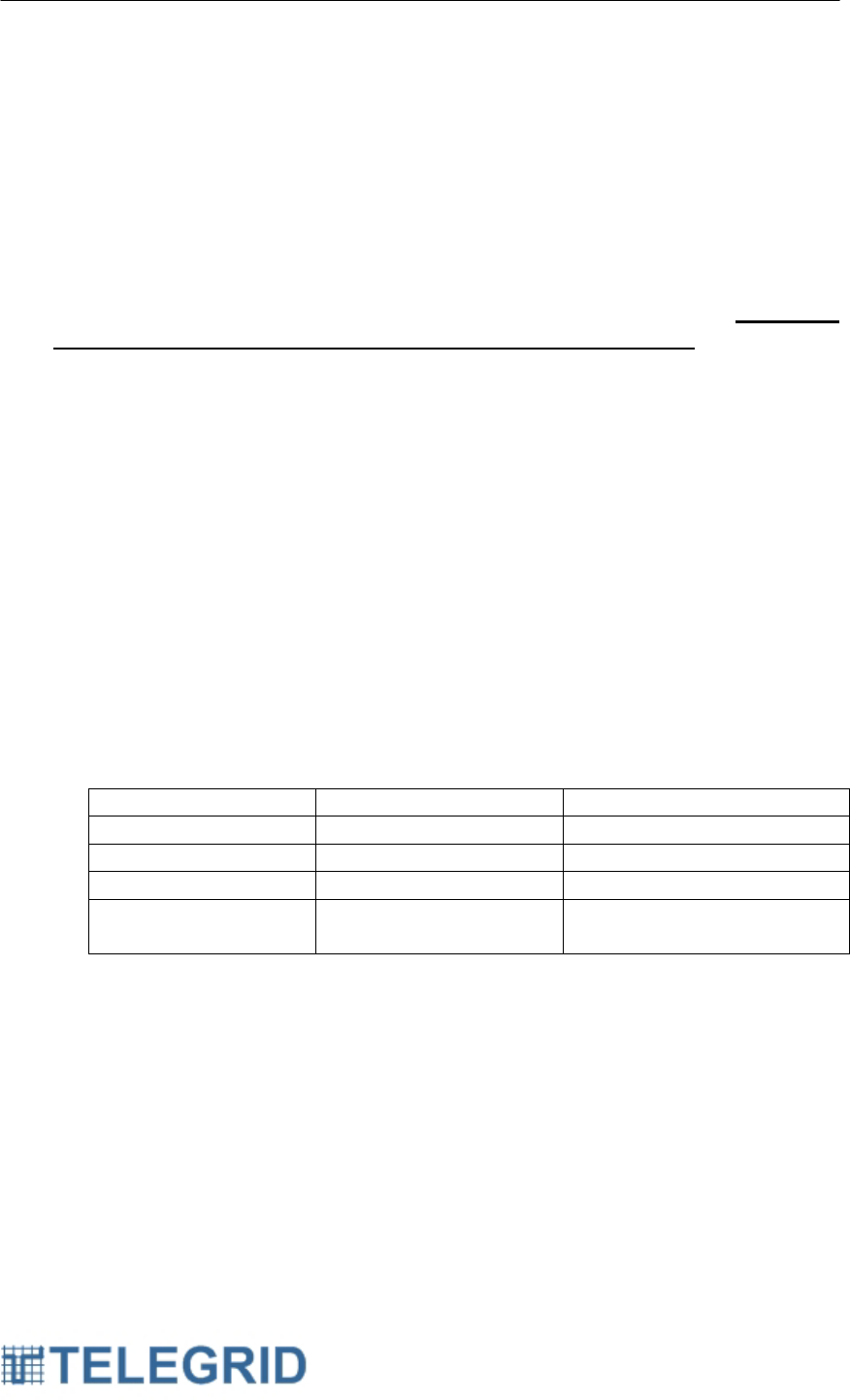
WRN-320(V)2 User Manual
8
SECTION 3: REPEATER POWER
1. Repeater Power
Main power to the WRN-320(V)2 is provided by either an internal
rechargeable 3500mAhr Lithium Ion battery or by an external power source
connected to the Relay’s AC Inlet. The battery pack is constantly monitored
and protected by an embedded battery gauge circuit. It is recharged
whenever an external power source is connected to the AC inlet. The mini-
USB port is for troubleshooting and not for charging. An internal
charger circuit determines whether the power is being supplied by battery
pack or through an external power source.
The Relay’s on-board voltage regulator provides one output of 3.3VDC.
1.1 Battery Charging
The battery pack is recharged via the AC inlet. This can be done by
plugging in the AC cord.
1.2 Battery LED
The current state of the Repeater’s battery pack status is displayed with
an LED on the side of the device. The user can use the LED to monitor
the voltage and be alerted when the battery is low. When the battery
voltage drops below a predetermined level, the Repeater will shut down
automatically to save power.
LED Status Minimum Voltage Maximum Voltage
Not Illuminated 3.8v
Solid 3.5v 3.8v
Flashing 3.3v 3.5v
Automatic
shutdown
0 3.3v

WRN-320(V)2 User Manual
9
SECTION 4: MODES OF OPERATION
1. Start-up Mode
The Repeater enters Start-up Mode when the battery pack is charged and
the power switch is flipped. In the absence of a charged battery pack, the
Repeater enters Start-up Mode when an external power source, i.e., a wall
charger is connected to the AC Inlet.
When Start-up Mode is entered, the microcontroller checks the condition of
the battery supply to determine if it should proceed to Power-on Mode.
2. Power-on Mode
The Repeater is always operating in Power-on Mode when it is running at
maximum clock frequency with all the peripherals fully functional.
3. Power-off Mode
The Repeater enters Power off Mode by a controlled power-off sequence or
by an uncontrolled power off sequence. Both sequences will cause the
main regulator to be disabled as the voltage supply disappears, thus the
Repeater will remain off.
3.1 Controlled Power off
The WRN-320(V)2 can be powered off by flipping the power switch on
the device.
3.2 Uncontrolled Power-off
The Repeater is powered off automatically if the battery voltage falls
below a predetermined threshold or if the battery is removed from the
Repeater. The Repeater is also powered off when the battery gauge
disconnects the battery due to over temperature, over voltage, or under
voltage.
Return to the Power-on Mode occurs when an external power source,
i.e., a wall charger is connected.
4. No Supply Mode
The Repeater enters this mode if the battery pack is completely depleted
and the voltage level falls below the undervoltage threshold.
Return to the Power-on Mode occurs when an external power source, i.e., a
wall charger is connected.

WRN-320(V)2 User Manual
10
SECTION 5: NETWORK COMMUNICATIONS
1. Overview
The networking technology employed by WZRDnet is based on the IEEE
802.15.4 protocol. Each Wireless Mesh Network (WMN) is defined with a
unique WMN Identifier (WMN ID).
2. Mesh Networking
WZRDnet supports mesh routing, allowing data packets to traverse multiple
nodes in order to reach the destination node. This allows nodes to be
spread out over a large region while still supporting communications among
all nodes in the network.
3. Router
A Router must associate with a WMN before it can transmit, receive, or
route data. In order to associate with a network the node must be provided
the following network information:
• Operating channel
• WMN ID
• Network Key (for encryption only).
Handsets, Repeaters and Gateways are all considered Routers in the Mesh
Network.
4. Ad-Hoc Network
WZRDnet is an ad-hoc network that is a comprised of self-configuring
handsets, Repeaters and gateways. These devices either form a new
network or associate with the nearest available network. This encourages
large-scale networks with minimal infrastructure support required.
4.1 Network Formation
A network is formed by selecting an operating channel and WMN ID.
Encrypted networks require assigning a network key for nodes to
decipher data.
4.1.1 Operating Channel
A WMN can operate on twelve channels from 1 to 12. The channel
can be changed in cases of noise or excessive traffic through the
WZRDnet Command Center software. For instructions on
changing the Channel see the WZRDnet Command Center User
Manual.

WRN-320(V)2 User Manual
11
4.1.2 WMN ID
The WMN ID is used to uniquely identify a WMN on a specific
channel. Multiple WMNs can operate independently on the same
channel as long as each is assigned a unique WMN ID. For
instructions on changing the WMN ID see the WZRDnet Command
Center User Manual.
4.1.3 Network Key
The network key is used to encrypt and decrypt packets on a
secure network. The Repeater must have the correct key in order
to decipher packets.
4.2 Associating with a WMN
WZRDnet Repeaters include a factory preset WMN ID and operating
channel. The operating channel and the WMN ID can be changed with
the WZRDnet Command Center software. For instructions on changing
the Node WMN ID see the WZRDnet Command Center User Manual.
5. Network Addressing
The 802.15.4 protocol specifies a 64-bit MAC address. A Node Identifier
String can also be specified as a simple way to route packets to the
underlying address.
5.1 64-bit MAC Address
Each node contains a unique IEEE defined 64-bit MAC address. The 64-
bit address uniquely identifies a node and is static.
5.2 Node Identifier String (NI)
A node can be assigned a character based Node ID. The Node ID can
be used to route messages to a specific node. The Node ID will then be
linked to the underlying MAC address for packet transmission. For
instructions on changing the NI String see the WZRDnet Command
Center User Manual.
SECTION 6: SECURE COMMUNICATIONS
1. Encryption
The WZRDnet system can be set for secure or non-secure communication.
If security is enabled, the network employs 128-bit AES encryption with a
Network Key. Only devices that have the same security key can
communicate on the WMN. Routers that associate with a secure WMN must
obtain the correct security key.
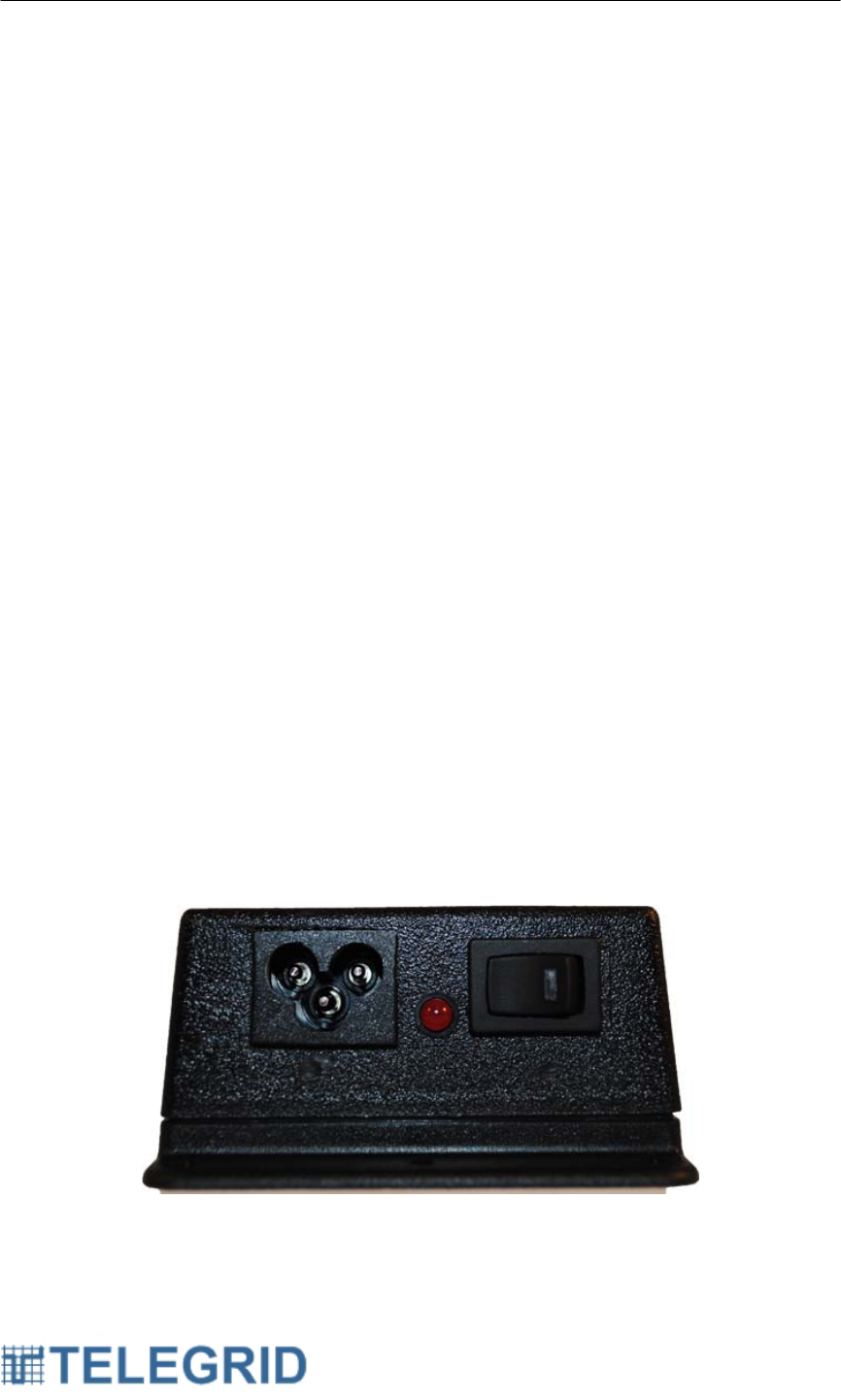
WRN-320(V)2 User Manual
12
1.1 Network Key
The Network Key is used to apply 128-bit AES encryption to all network
level transmissions.
1.2 Key Update
The Network Key can be upgraded from WZRDnet Command Center
software. For instructions on changing the Network Key see the
WZRDnet Command Center User Manual.
SECTION 7: OPERATING INSTRUCTIONS
1. Network Association
1.1 Change Channel
If a channel becomes crowded it is possible for a Repeater to switch to a
new channel with the WZRDnet Command Center software. For
instructions on changing the CH String see the WZRDnet Command
Center User Manual.
1.2 Assigning Node Identifier Strings
Each WRN-320(V)2 Relay comes with a factory set Node Identifier
String. The network administrator can change the Node Identifier String
with the WZRDnet Command Center software. For instructions on
changing the Node Identifier String see the WZRDnet Command Center
User Manual.
2. Getting Started
2.1 Buttons and Connectors
Figure 7.2.1 External Power Connection

WRN-320(V)2 User Manual
13
2.2 Battery Voltage Indicator
The battery voltage indicator LED is located at the bottom of the
Repeater. Low voltage will result in a solid red LED. Extremely low
voltage is indicated when the LED begins to flash. The Repeater will
power off when the voltage drops below the minimum required threshold.
When the light is not illuminated it is fully charged.
2.3 Charging the Battery
Charging the battery can be performed by AC wall adapter. Repeater
operation is permitted while charging. Use only approved chargers with
the WRN-320(V)2.
2.3.1 AC Wall Adapter Charging
1. Attach the AC wall adapter to the mini-USB port on the bottom
of the Repeater.
2. Attach the AC wall adapter to a wall outlet.
2.4 Turning ON/OFF
To turn the Repeater on and off simply flip the power switch on or off.
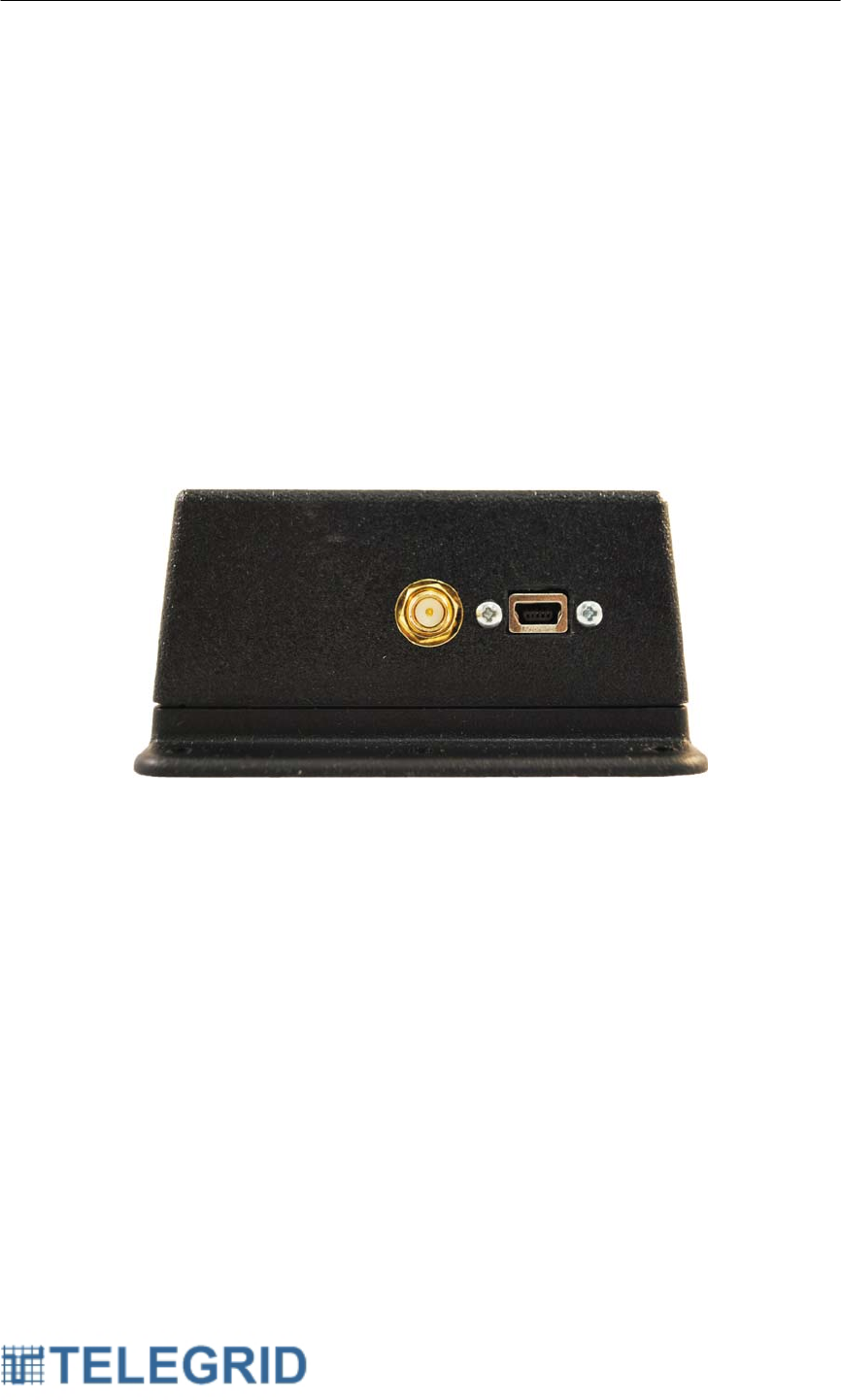
WRN-320(V)2 User Manual
14
SECTION 8: TROUBLESHOOTING
1. Mini-USB Port
The WRN-320(V)2 includes a mini-USB port for troubleshooting. The Operating
Channel, WMN ID, and Network Key can be changed wirelessly via the
WZRDnet Command Center. If a system administrator cannot access the WRN-
320(V)2 wirelessly it is also possible to connect to the Repeater via the mini-USB
port.
In order to connect attach the Repeater to a PC via a mini-USB to USB cable.
Open WZRDnet Command Center and click on Network in the menu bar. To
change Repeater information follow the instructions in the WZRDnet Command
Center User Manual
Figure 8.1.1 Mini- USB Port
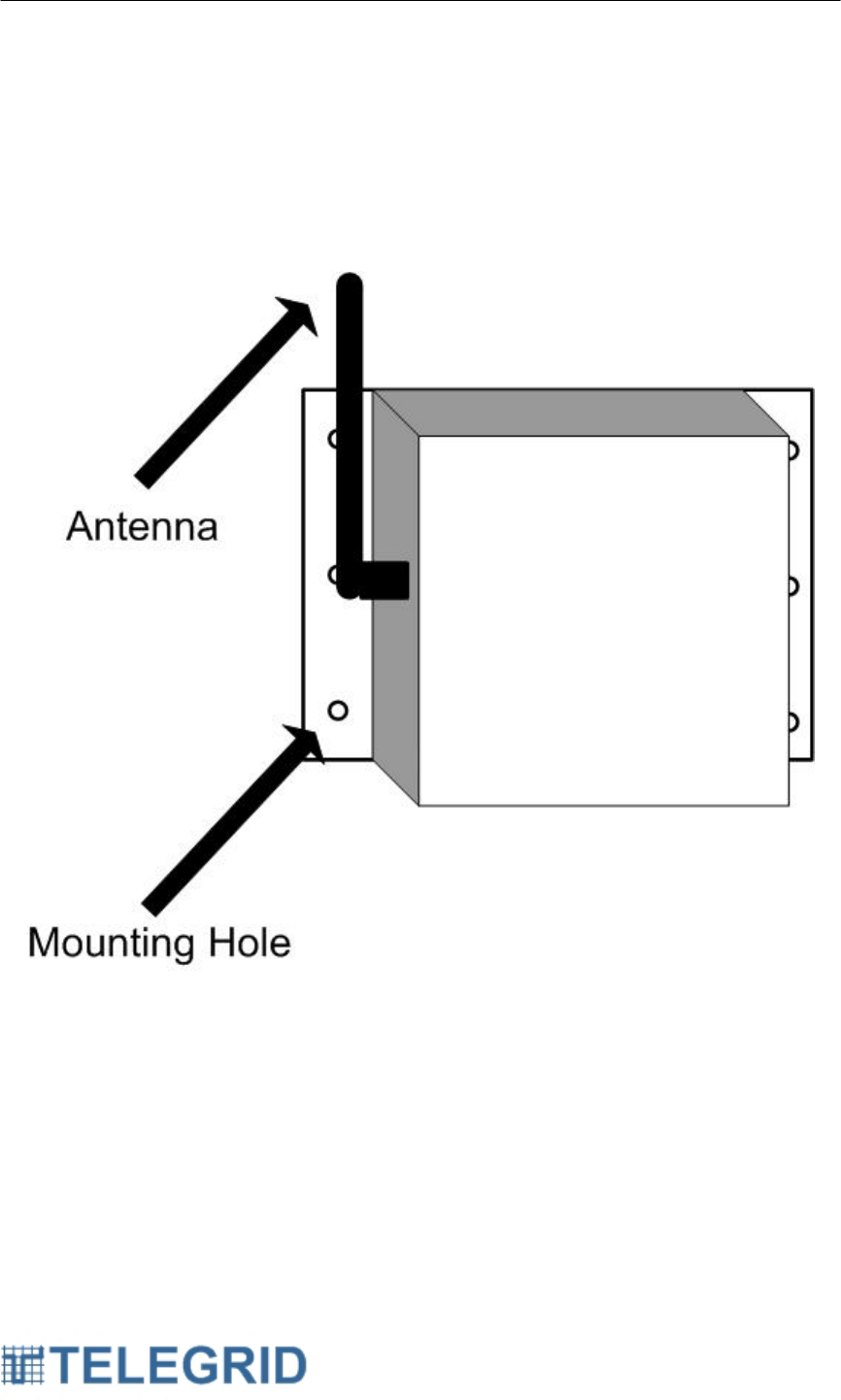
WRN-320(V)2 User Manual
15
SECTION 9: INSTALLATION INSTRUCTIONS
The WRN-320(V)2 has mounting holes on both sides of the Repeater for
installation along a wall The WRN-320(V)2 must be installed horizontally along a
wall with the antenna bent at a right angle as shown in Figure 9.1.
Figure 9.1 WRN-320(V)2 Installation
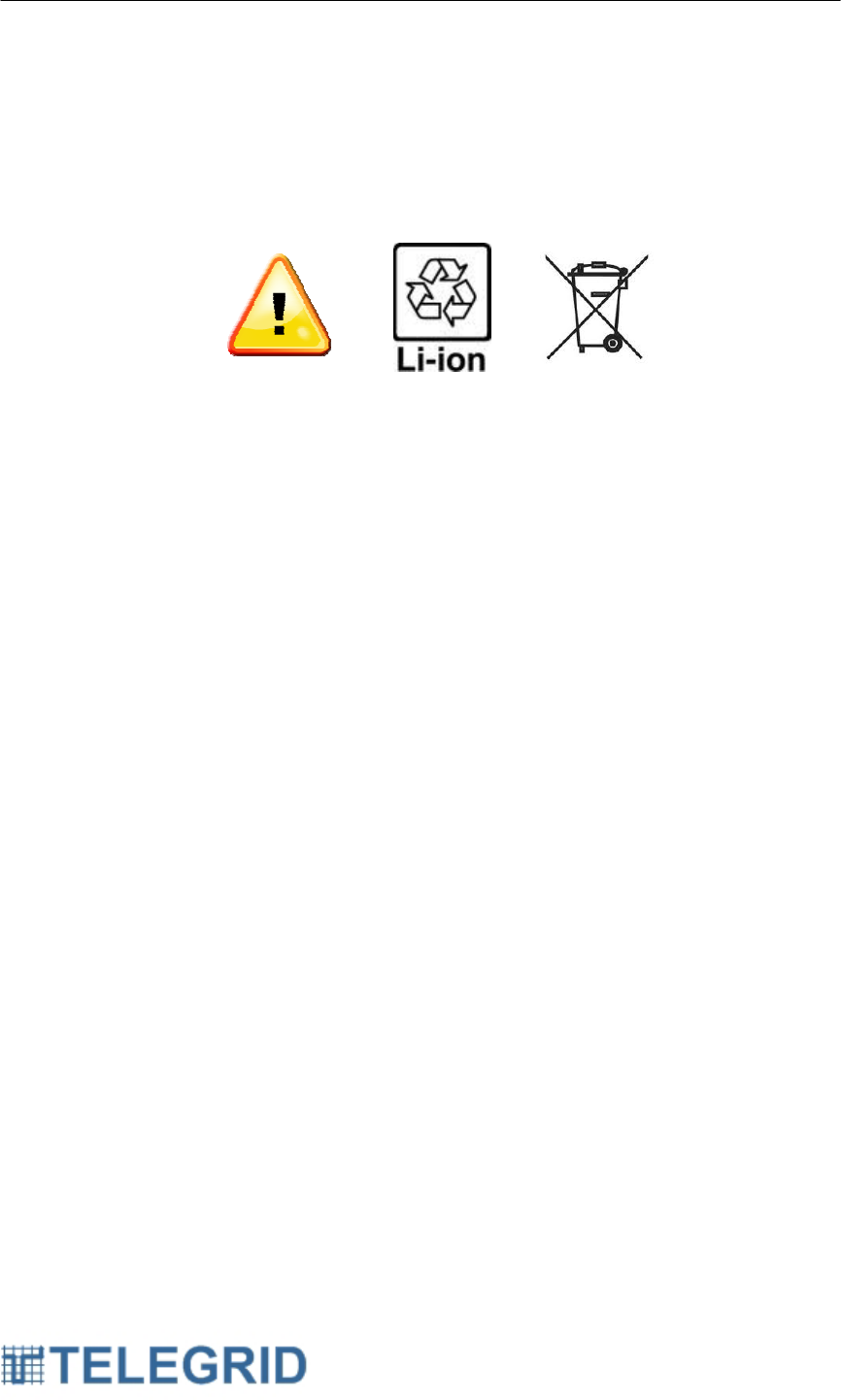
WRN-320(V)2 User Manual
16
SECTION 10: PRODUCT AND SAFETY INFORMATION
1. WRN-320(V)2 Safety Instructions
Do not disassemble, crush, open, bend, deform, microwave or puncture
Handset.
Avoid dropping Repeater.
Avoid excessive pressure on Repeater.
Do not expose to extreme temperatures, liquid, moisture, or high humidity.
Repeater contains small parts which may present a choking hazard.
Keep metal objects away from connectors and battery terminals.
Do not expose to open flames.
Do not dispose of Repeater in fire or water.
Recycle or dispose of Repeater according to local regulations.
Do not use harsh chemicals, aerosol cleaners or solvents to clean the
Repeater
Avoid dramatic shifts in temp as will cause moisture. Allow sufficient time for
moisture to evaporate before using the Repeater.
Avoid pushing objects into the Repeater as this action might cause a short
circuit, a fire, or electric shock. Never force a connector into a port.
Do not disassemble Repeater or accessories.
Do not repair or service the Repeater yourself.
Turn your Repeater OFF where posted notices so require.
Failure to observe all safety instructions will void Warranty.
1.1 Battery Information
The WRN-320(V)2 contains rechargeable Lithium Ion batteries. Lithium
Ion batteries pose a risk of fire, explosion, leakage, or other hazard.
Replace only with approved batteries. Recycle or dispose of used
batteries according to local regulations.
Use only approved batteries and chargers. Use of an unapproved
battery or charger may present a risk of fire, explosion, leakage, or other
hazard.
Do not disassemble, crush, open, bend, deform, microwave or puncture
battery.
Avoid dropping battery.

WRN-320(V)2 User Manual
17
Keep metal objects away from battery terminals.
Do not expose battery to extreme temperatures, fire, direct sunlight,
liquid, moisture, or high humidity.
Do not use batteries that appear damaged, deformed, discolored, rust or
emits foul odor.
In the event the battery leaks and the fluid gets into one's eye, do not rub
the eye. Rinse well with water and immediately seek medical care. If left
untreated, the battery fluid could cause damage to the eye.
Do not use charger if the power cord or plug has become frayed or
damaged; The charger is exposed to rain, liquid, or excessive moisture;
The charger has become damaged.
1.2 Antenna
Use only approved replacement antennas. Unauthorized antennas or
modifications could damage your Repeater or result in a violation of
wireless regulations.
Do not use any Repeater that has a damaged antenna. If a damaged
antenna comes into contact with your skin, a minor burn can result.
1.3 Health and General Use
Repeater is designed for mobile and fixed uses. Repeater is not
designed for portable use and should be kept at least 20cm away from
the body.
Avoid use on Aircraft. RF Interference might disrupt instrumentation,
communication and performance; Might disrupt the network; Might be
illegal. Turn your Repeater OFF before boarding an aircraft. Always
request and obtain prior consent and approval of an authorized airline
representative before using your Repeater aboard an aircraft. Always
follow the instructions of the airline representative whenever using your
Repeater aboard an aircraft, to prevent any possible interference with
airborne electronic equipment
Do not place the Repeater in the area over an air bag or in the air bag
deployment area. Air bags inflate with great force. If a Repeater is
placed in the air bag deployment area and the air bag inflates, the
Repeater may be propelled with great force and cause serious injury to
occupants of the vehicle.
Do not use in explosive atmosphere in presence of explosive fumes,
explosive dust, or other explosive chemicals. Sparks could cause fire or
explosion resulting in serious injury or death.

WRN-320(V)2 User Manual
18
Areas with a potentially explosive atmosphere are often, but not always,
clearly marked. They include fueling areas such as gasoline or petrol
stations; below deck on boats; fuel or chemical transfer or storage
facilities; vehicles using liquefied petroleum gas (such as propane or
butane); areas where the air contains chemicals or particles, such as
grain, dust, or metal powders; and any other area where you would
normally be advised to turn off your vehicle engine.
Blasting areas: To avoid interfering with blasting operations, turn off all
wireless connections on the Repeater when in a “blasting area” or in
areas posted: “Turn off two-way radio”. Obey all signs and instructions.
Use of Repeater when driving, riding or walking is not recommended and
is illegal in some areas. Comply with local laws and regulations
regarding use of wireless Handsets when driving, riding or walking.
Pacemakers: The Advanced Medical Technology Association
(AdvaMed) recommends that a minimum separation of 6 inches (15
centimeters) be maintained between a handheld wireless handset and a
pacemaker.
These recommendations are consistent with those of the U.S. Food and
Drug Administration.
Persons with pacemakers should:
• ALWAYS keep the handset more than 6 inches (15 centimeters)
from their pacemaker when the handset is turned ON.
• Not carry the handset in the breast pocket.
• Use the ear opposite the pacemaker to minimize the potential for
interference.
• Turn the handset OFF immediately if you have any reason to
suspect that interference is taking place.
Hearing Aids: Some digital wireless radios may interfere with some
hearing aids. In the event of such interference, you may want to consult
your hearing aid manufacturer to discuss alternatives.
This Repeater may cause RF Interference with other personal medical
equipment. Consult manufacturer of medical equipment to determine if it
is adequately shielded
Do not rely on this Repeater during emergencies. All wireless devices
operate using radio signals which cannot guarantee a connection at all
times due to network availability or environmental interference.

WRN-320(V)2 User Manual
19
SECTION 11: CERTIFICATIONS
1. Certifications
FCC ID: XAYWRN310V2
IC ID: 9251A-WRN310V2
1.1 FCC Notice
This device complies with Part 15 of the FCC Rules. Operation is
subject to the following two conditions: (1) this device may not cause
harmful interference and (2) this device must accept any interference
received, including interference that may cause undesired operation.
Note: This equipment has been tested and found to comply with the
limits for a Class B digital device, pursuant to Part 15 of the FCC Rules.
These limits are designed to provide reasonable protection against
harmful interference in a residential installation. This equipment
generates, uses and can radiate radio frequency energy and, if not
installed and used in accordance with the instruction manual, may cause
harmful interference to radio communications. However, there is no
guarantee that interference will not occur in a particular installation. If
this equipment does cause harmful interference to radio or television
reception, which can be determined by turning the equipment off and on,
the user is encouraged to try to correct the interference by one or more
of the following measures:
• Re-orient or relocate the receiving antenna
• Increase the separation between the equipment and receiver
• Connect the equipment into an outlet on a circuit different from that
to which the receiver is connected
• Consult the dealer or an experienced radio/TV technician for help.
Warning: Changes or modifications not expressly approved by
TELEGRID Technologies, Inc. could void the user’s authority to operate
the equipment.
1.2 Industry Canada (IC)
This device complies with the Class B limits for radio noise emissions as
set out in the interference-causing equipment standard entitled “Digital
Apparatus,” ICE-003 of Industry Canada. Cet appareil numérique de la
classe A est conforme à la norme NMB-003 du Canada. This Category
II radiocommunication device complies with Industry Canada Standard
RSS-310. Ce dispositif de radiocommunication de catégorie II respecte
la norme CNR-310 d'Industrie Canada. This device complies with RSS
210 of Industry Canada under certification number 9251A-WRN310V2.

WRN-320(V)2 User Manual
20
SECTION 12: LEGAL NOTICES
THE SPECIFICATIONS AND INFORMATION REGARDING THE PRODUCTS
IN THIS MANUAL ARE SUBJECT TO CHANGE WITHOUT NOTICE. ALL
STATEMENTS, INFORMATION, AND RECOMMENDATIONS IN THIS MANUAL
ARE BELIEVED TO BE ACCURATE BUTARE PRESENTED WITHOUT
WARRANTY OF ANY KIND, EXPRESS OR IMPLIED. USERS MUST TAKE
FULL RESPONSIBILITY FOR THEIR APPLICATION OF ANY PRODUCTS.
1. Copyright
Copyright ©2012 TELEGRID Technologies, Inc. All rights reserved. This
manual contains proprietary information that belongs to TELEGRID
Technologies, Inc. and is protected by copyright. This information is
intended for internal use only and is not to be disclosed to third parties. No
part of this publication may be copied, reproduced, stored in a retrieval
system, or transmitted, by any means, electronic or mechanical without
written consent from TELEGRID Technologies, Inc. TELEGRID® is a
registered trademark of TELEGRID Technologies, Inc.
2. Software Licensing Agreement
By clicking on the “Accept” button, opening the package, downloading the
product, or using the equipment that contains this product, you are
consenting to be bound by this Agreement.
TELEGRID shall grant Customer a limited, non-exclusive subscription to
use the TELEGRID software (“Software”), per the terms set forth below.
The Agreement shall entitle Customer to use the Software with the
hardware communication devices purchased from TELEGRID (“Hardware”)
to facilitate communications between the Hardware. The Customer is also
entitled to use the Software with other equipment to provide a
communication interface between the Hardware and other equipment,
provided however, that Customer may not modify the Software in any
manner. Customer may not re-sell, lease, license or distribute the Software
by themselves or as part of any collection, product or service. Customer
may not copy, in whole or in part, Software or documentation; modify the
Software; reverse compile, reverse engineer or reverse assemble all or any
portion of the Software.
Software maintenance includes the publishing of bug/defect fixes via
patches and updates/upgrades in function and technology to maintain the
operability and usability of the Software. It may also include other support
such as user blogs, discussion forums, on-line help libraries and FAQs
(Frequently Asked Questions), hosted chat rooms, and limited telephone,
email and/or web-based general technical support for user’s self

WRN-320(V)2 User Manual
21
diagnostics. This software maintenance is not included with the Software
and is available for an extra fee.
Software integration includes the creation, design, implementation, etc. of
the Software. This software integration is not included with the Software and
is available for an extra fee.
This Agreement will continue in perpetuity until terminated by either Party
upon 90 days prior written notice, unless otherwise stated. If the Customer
does not meet its obligations as set forth in this Agreement then TELEGRID
shall have the immediate right to terminate this Agreement. In addition, this
Agreement may be terminated by TELEGRID without notice based on any
breach of the provisions of the hardware agreements for the equipment
supplied by TELEGRID. Customer’s obligation to pay all charges that have
accrued will survive any termination of this Agreement.
All materials whether provided physically, electronically (on-line or on a
tangible media), including, but not limited to set-up guides, operating
manuals, and help manuals furnished by TELEGRID to the Customer
(“Materials”) are licensed (not sold). Customer is granted a personal, non-
transferable, and nonexclusive subscription to use Materials solely for
Customer’s own internal business use. Customer does not have the right to
copy, distribute, reproduce, alter, display, or use these Materials or any
TELEGRID trademarks for any other purpose except as it relates to internal
communication. Customer agrees that (a) it will keep Materials confidential
and will use commercially reasonable efforts to prevent and protect the
content of Materials from unauthorized use and (b) its subscription to use
Materials ends on the termination date of this Agreement. Upon
termination, Customer agrees to destroy materials and provide
documentation certifying destruction of said materials.
Customer agrees that aspects of the licensed materials, including the
specific design and structure of individual programs, constitute trade secrets
and/or copyrighted material of TELEGRID. Customer agrees not to
disclose, provide, or otherwise make available such trade secrets or
copyrighted material in any form to any third party without the prior written
consent of TELEGRID. Customer agrees to implement reasonable security
measures to protect such trade secrets and copyrighted material. Title to
Software and documentation shall remain solely with TELEGRID.
Software, including technical data, is subject to U.S. export control laws,
including the U.S. Export Administration Act and its associated regulations,
and may be subject to export or import regulations in other countries.
Customer agrees to comply strictly with all such regulations and
acknowledges that it has the responsibility to obtain licenses to export, re-
export, or import Software.

WRN-320(V)2 User Manual
22
TELEGRID’s Software is provided to the Government with RESTRICTED
RIGHTS and its supporting documentation is provided with LIMITED
RIGHTS. Use, duplication, or disclosure by the Government is subject to
the restrictions set forth in the FAR 52.227-19. The Software and its
supporting documentation were developed at private expense and its use,
duplication, or disclosure by the United States Government is subject to
restrictions as set forth in DFARS 252.227-7013, DFARS 252.227-7014, or
DFARS 252.227-7015.
EXCEPT AS EXPRESSLY SET FORTH IN THIS AGREEMENT, THE
MAXIMUM TOTAL LIABILITY OF TELEGRID TO CUSTOMER SHALL NOT
EXCEED THE TOTAL AMOUNT PAID BY CUSTOMER FOR THE
DEFECTIVE SOFTWARE CAUSING THE DAMAGE DURING THE 12
MONTHS IMMEDIATELY PRECEDING THE LOSS. THIS REMEDY IS
CUSTOMER’S SOLE AND EXCLUSIVE REMEDY. TELEGRID SHALL
NOT BE RESPONSIBLE FOR ANY SPECIAL, INCIDENTAL, OR
CONSEQUENTIAL DAMAGES EVEN IF TELEGRID HAS KNOWLEDGE
OF THE POSSIBILITY OF SUCH POTENTIAL LOSS OR DAMAGE.
This Agreement and the Parties rights and obligations shall be governed
and construed pursuant to the laws of the State of New Jersey; (b) Any
lawsuit concerning this contract shall be brought in a court of competent
jurisdiction in Essex County, New Jersey; (c) Customer consents to be
subject to the jurisdiction of the state or federal courts located in Essex
County, New Jersey; (d) Customer may not assign this Agreement except
with TELEGRID’s prior written approval; (e) No action under this Agreement
may be brought by either party more than one year after the cause of action
has occurred.
If any provision of this Agreement or any construction or application of any
provision of this Agreement is held to be unenforceable or invalid for any
reason, then the validity of all the remaining provisions shall not be affected
and the validity of any remaining construction or application of the provision
shall not be affected, and the rights or obligations of each of the parties
hereto shall be construed and enforced as if the Agreement did not contain
such invalid provision or, as the case may be, invalid construction or
application of such provision; provided, however, that such resulting
construction and enforcement shall be generally consistent with the basic
purpose of this Agreement. For this purpose, “provision” refers to any word,
phrase, dollar amount, part, term or other portion of this Agreement.
THE EXPRESS WARRANTIES SPECIFIED IN THIS AGREEMENT ARE IN
LIEU OF ALL OTHER WARRANTIES, EXPRESS OR IMPLIED,
INCLUDING WITHOUT LIMITATION, ANY WARRANTIES OF

WRN-320(V)2 User Manual
23
MERCHANTABILITY OR FITNESS FOR A PARTICULAR PURPOSE.
TELEGRID DISCLAIMS AND EXCLUDES ALL OTHER WARRANTIES.
EXCEPT AS PROVIDED OTHERWISE IN THIS AGREEMENT, TELEGRID
PROVIDES THIS SOFTWARE ON AN "AS IS" BASIS WITHOUT
FURTHER WARRANTIES OF ANY KIND, INCLUDING, BUT NOT LIMITED
TO, WARRANTIES OF TITLE OR IMPLIED WARRANTIES OF
MERCHANTABILITY, OTHER THAN THOSE WARRANTIES WHICH ARE
IMPLIED BY AND INCAPABLE OF EXCLUSION, RESTRICTION OR
MODIFICATION UNDER THE LAWS APPLICABLE TO THIS
AGREEMENT.
Third Party Software: TELEGRID Technologies, Inc. products may include
copyrighted third-party software stored in semiconductor memories or other
media. Laws in the United States and other countries preserve for third-
party software providers certain exclusive rights for copyrighted software,
such as the exclusive rights to distribute or reproduce the copyrighted
software. Accordingly, any copyrighted third-party software contained in
TELEGRID Technologies, Inc. products may not be modified, reverse-
engineered, distributed, or reproduced in any manner to the extent allowed
by law. Furthermore, the purchase of TELEGRID Technologies, Inc.
products shall not be deemed to grant either directly or by implication,
estoppel, or otherwise, any license under the copyrights, patents, or patent
applications of any third-party software provider, except for the normal, non-
exclusive license to use that arises by operation of law in the sale of a
product. The software included in this product may contain copyrighted
software that is licensed under the GPL. For more information and to obtain
possible Corresponding Source code from us for a period of three years
after our last delivery of this product email GPL@telegrid.com.
3. Limited Warranty
TELEGRID TECHNOLOGIES, INC. (“TELEGRID”) warrants to the
Customer that the equipment to be delivered hereunder will be free from
defects in material and in workmanship for a period of one year (“Warranty
Period”) from the date of delivery by TELEGRID unless extended at the time
of purchase as evidenced by adequate documentation.
The Customer must notify TELEGRID within 30 days of any claimed defect.
Any equipment which becomes defective due to material or workmanship
during the Warranty Period will be promptly repaired or replaced by
TELEGRID at its option using either new or like new equipment.
TELEGRID warrants the items repaired or replaced under this clause will be
free from defects in material and workmanship for ninety (90) days from
date of delivery by TELEGRID, or the balance of the Warranty Period for the
equipment, whichever is longer. Equipment found not to be defective will be

WRN-320(V)2 User Manual
24
returned to the Customer, freight charges collect, and charges will be
forwarded to the Customer for inspection and test time. Transportation
charges for equipment found to be defective within the Warranty Period will
be paid by TELEGRID to and from the original point of acceptance.
TELEGRID’s liability to the Customer shall not in any case exceed the cost
of correcting defects in the equipment as provided herein or the price paid to
TELEGRID by the Customer, whichever is less.
TELEGRID will not warrant any equipment if, during the Warranty Period the
Customer: (a) fails to follow applicable operation, maintenance, or
environmental requirements described in any of the manuals and other
materials provided to the Customer, including without limitation product
bulletins; (b) makes additions to, alters, modifies, enhances, repairs or
disassembles the equipment (itself or using a third party) without
TELEGRID’s written consent; (c) mishandles, abuses, misuses or damages
the equipment (either itself or by others doing so).
TELEGRID will not warrant any equipment damaged due to fire, explosion,
power irregularities, power surges, Acts of God (including, without limitation,
earthquakes, rains, floods or lightning), or any other cause not attributable
to TELEGRID.
Upon expiration of the Warranty Period, all warranty liability shall terminate.
The foregoing shall constitute the sole remedy of the Customer and the sole
liability of TELEGRID and shall be in lieu of any other Warranty, implied,
statutory, or otherwise, including the Warranty of Merchantability.
TELEGRID SHALL NOT BE LIABLE FOR INCIDENTAL, SPECIAL,
INDIRECT OR CONSEQUENTIAL DAMAGES.
4. Jurisdiction
This Customer’s rights and obligations shall be governed and construed
pursuant to the laws of the State of New Jersey; (b) Any lawsuit concerning
this product shall be brought in a court of competent jurisdiction in Essex
County, New Jersey; (c) Customer consents to be subject to the jurisdiction
of the state or federal courts located in Essex County, New Jersey; (d)
Customer may not assign this Agreement except with TELEGRID’s prior
written approval; (e) No action may be brought by the Customer more than
one year after the cause of action has occurred.